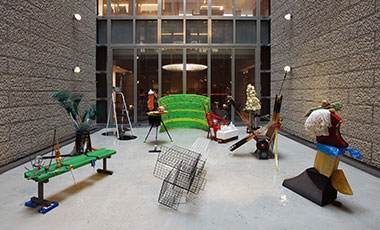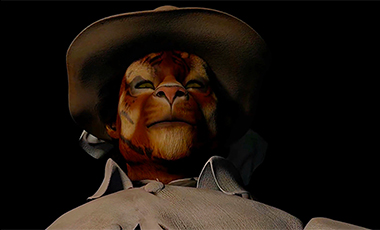

Image provided by WIDEWALLS
In addition to boasting one of the most effective COVID-19 responses on the planet, South Korea is also currently home to one of the most fascinating abstract art exhibitions of the summer: Lee Seung Jio: Advancing Columns, at The National Museum of Modern and Contemporary Art, Korea.
Born in 1941, Lee Seung Jio was part of a generation of pioneering abstractionists that helped define Korean Modernism in the wake of World War II and the reverberating traumas of the Japanese occupation. The concern that was most pressing to Lee Seung Jio and his contemporaries was how to establish a uniquely Korean concept of modernism, which was personal and contemporary, and yet also connected in some essential way to the long history of Korean art.
This was no easy task. The most popular style when Lee was in school was mimetic traditionalism, with Korean artists using Japanese techniques and Western styles to copy reality. Even those Korean artists who embraced abstraction borrowed the lyrical abstract styles of Tachisme and Abstract Expressionism, so-called “hot abstraction,” which allowed them to express subconscious emotion to assuage the pain of war.
Lee was in search of something more intellectual, and detached from emotion. He and two of his school mates—Choi Myoung-Young and Suh Seung-Won—founded the Origins group, which advocated for constructive approaches to painting that reconsidered the fundamentals of the medium.
They first embraced the essential fact that paintings are artworks that exist on unsentimental, completely objective canvases, which are fundamentally flat. Secondly, they noted the importance of the artist having control over the creation of the work, and exercising moderation in the creative process.
Each of the founders of the Origins group had different ideas about what was meant by control, moderation, flatness, and objectivity, but all three shared a belief that cool, rational abstraction would help them discover the true, lasting identity of Korean art.

Lee Seungjio: Advancing Columns Installation View National Museum of Modern Contemporary Art Korea. Image provided by WIDEWALLS
Capturing a Vision
The 90 paintings on view in Lee Seung Jio: Advancing Columns might seem at first to belong to several distinct bodies of work. Some are mostly black; others are black and white; still others contain a range of colors.
Yet, all of these works rely on a similar language of forms derived from tubes. In Korea, Lee is known as “the pipe artist,” a reference to the instantly recognizable, multitudinous networks of pipes and tubes that run through his paintings. Lee referred to his tube, or pipe, paintings as his Nucleus series.
Like the term "Origins", the word "Nucleus" refers back to the central basis of something. Lee considered the tubes to be geometric, rational, indifferent, and calculating. Also, the tube is a fundamentally modern form in a way, since contemporary society could not exist without pipes and conduits of various types. Yet, it is also an ancient form that goes back to the earliest pan flutes and aqueducts, and even human veins, arteries, and neurons. Tubes are simultaneously modern and ancient, symbolic and rational. For Lee, this made them an ideal subject to paint.
The Nucleus series also, however, emanated from a very personal experience that Lee had while traveling on a train—an experience this is both connected to the inner world of memory, and the outside, physical world. As the train he was on sped past the landscape, Lee was falling asleep while looking out the window. His barely open eyes watched as the passing, multicolored, multi-formed landscape blurred into a series of geometric, monochromatic lines. As his eyes finally closed, a synthesized, optical vision appeared to him. It profoundly affected him, but when he opened his eyes to try to capture it, it slipped away.
Lee spent days trying to recapture the vision in his studio. His lifelong drive to pursue his Nucleus series grew out of that vision, instigated by the sight of a quickly modernizing world speeding by him, and the optical memory of it that echoed behind his closing eyes.

Lee Seung-Jio - Nucleus F-G-999, 1970. Oil on canvas, 162 x 162 cm. Courtesy of family. Image provided by WIDEWALLS
Singular Perspectives
The experience that Lee had on that train could be an example of luck favoring the prepared mind. Timing, and all sorts of other conditions, conspired to combine into an image, which led to a body of images, all formed within the mind of an artist who was prepared to receive the vision, understand it, and pursue it to its logical ends.
However, it is that Lee had the courage to continually pursue this vision throughout his career that made him one of the most influential artists of his generation. His doggedness in the pursuit of something totally idiosyncratic, totally abstract, and totally detached from traditional methods was a political act.
Lee and the other Origins founders claimed artistic liberty, shrugging off the established academic and critical regime. In doing so, they inspired the artists of Dansaekhwa, as well as the Korean conceptual artists of the 1970s, and laid the groundwork for the incredibly diverse and unique Korean contemporary art field of today.
What is remarkable, however, about Lee, is that considered in its entirety, his oeuvre does, in fact, correlate in many ways with what is considered most essential to Korean art and cultural history. The simplicity and restraint demonstrated in his Nucleus paintings evokes the purity and frugality of Neo-Confucianism, the State religion in Korea during the Joseon Dynasty; his repeated variations on a visual theme in search of his imagined ideal echo the repeated lives of a Buddhist soul in search of Nirvana; the embrace of a rational form as a carrier of meaning reflects the utility and simplicity of the oldest known Korean artworks, 8,000-year-old Neolithic pottery.
By creating a modern, cool, objective, abstract position that was profoundly personal, and yet also undeniably connected to the most ancient, collective Korean traditions, Lee defined Korean Modernism as not only being about the search to “make it new,” but also being about claiming the entitlement to “make it you.”
Lee Seung Jio: Advancing Columns is on view through October 2020 at The National Museum of Modern and Contemporary Art, Korea, in Seoul.


